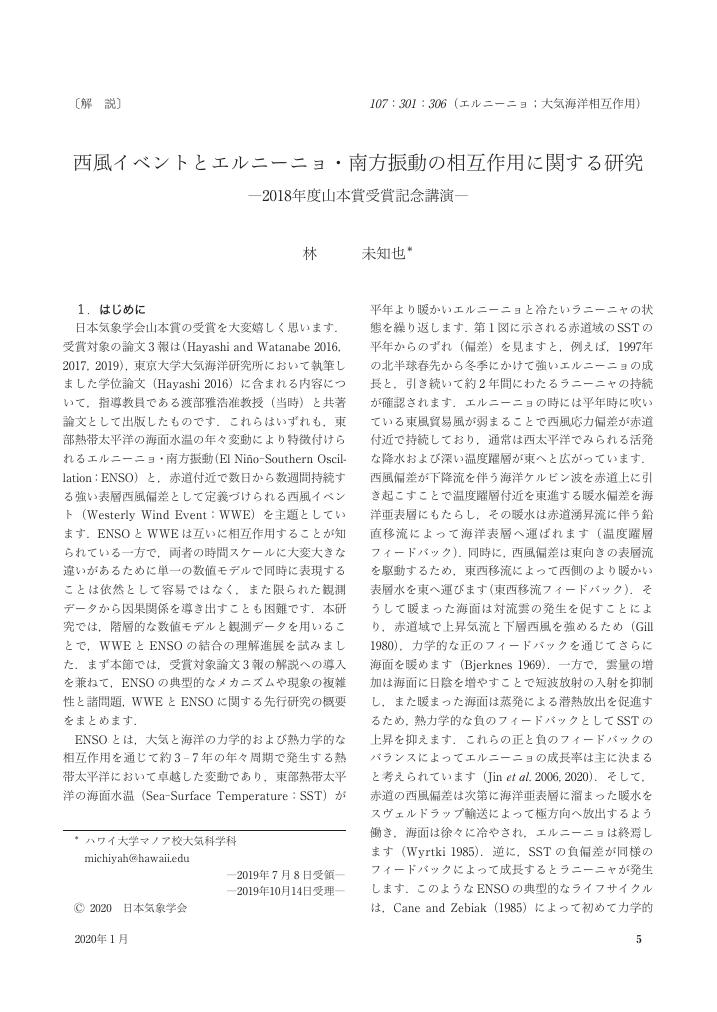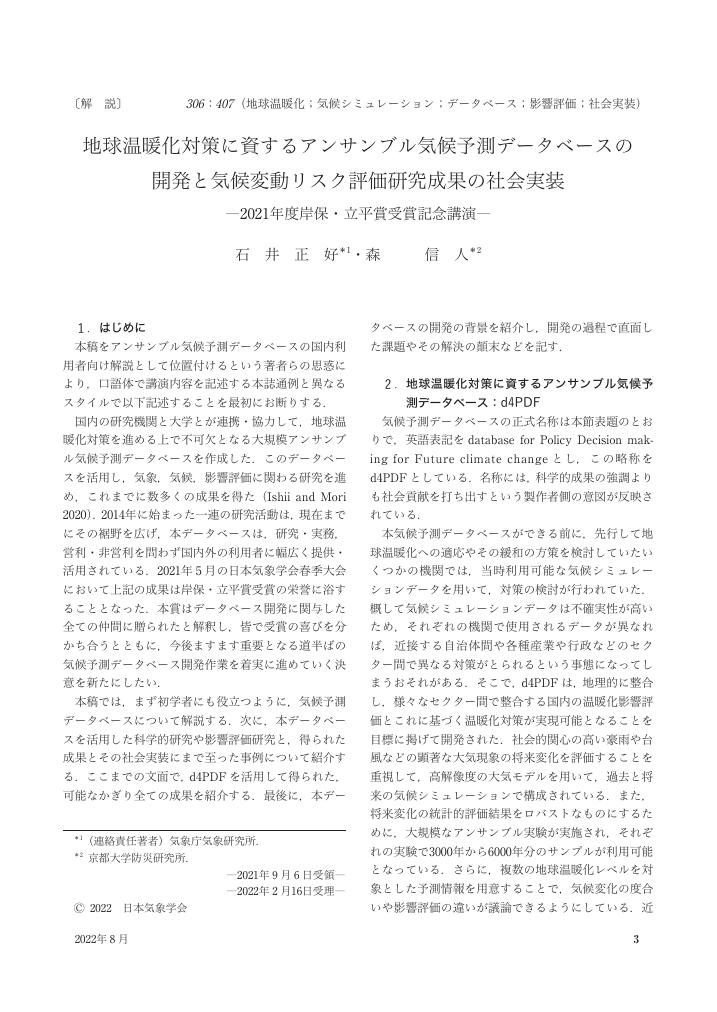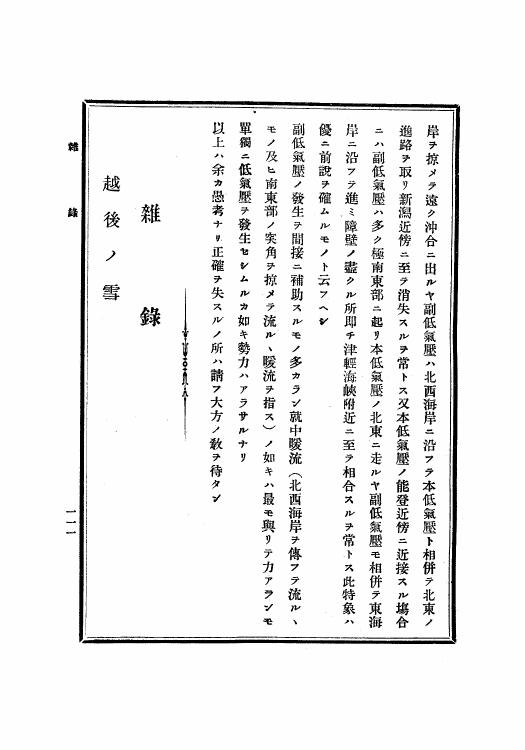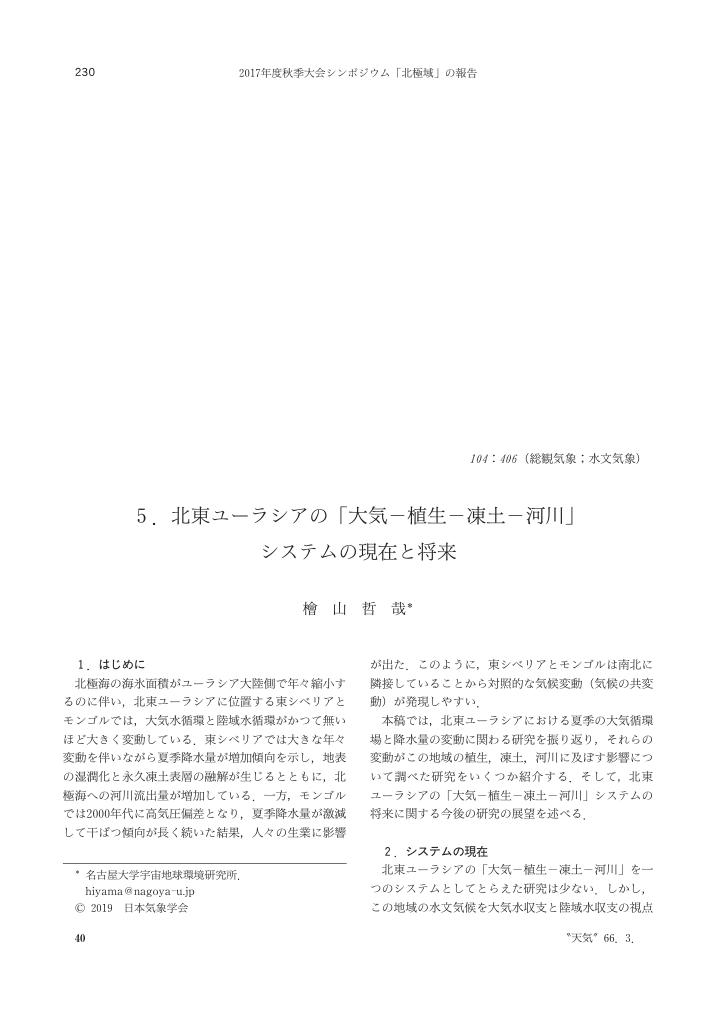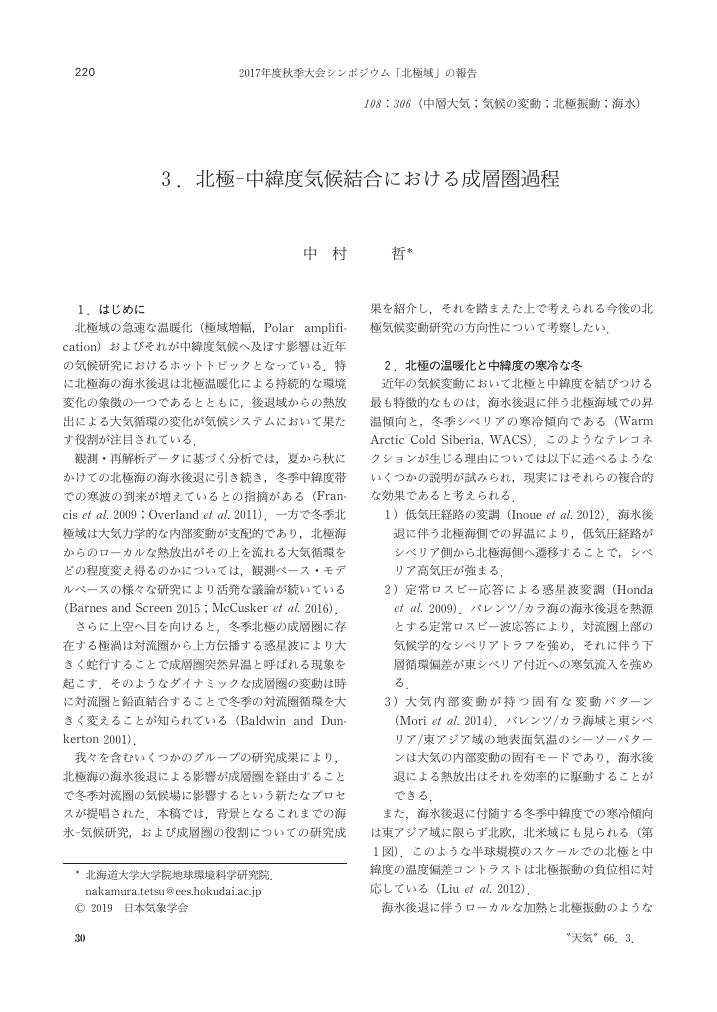- 著者
- 林 未知也
- 出版者
- 公益社団法人 日本気象学会
- 雑誌
- 天気 (ISSN:05460921)
- 巻号頁・発行日
- vol.67, no.1, pp.5-25, 2020 (Released:2020-02-29)
- 参考文献数
- 100
- 著者
- DATT Ishan CAMARGO Suzana J. SOBEL Adam H. MCTAGGART-COWAN Ron WANG Zhuo
- 出版者
- 公益社団法人 日本気象学会
- 雑誌
- 気象集誌. 第2輯 (ISSN:00261165)
- 巻号頁・発行日
- pp.2022-037, (Released:2022-05-13)
- 被引用文献数
- 3
A significant fraction of tropical cyclones develop in baroclinic environments, following tropical cyclogenesis “pathways” that are characterized by dynamical processes often associated with higher latitudes. This study investigates whether such storms are more likely to undergo subsequent extratropical transition than those that develop in more typical, non-baroclinic environments. We consider tropical cyclones globally in the period 1979-2011 using best-track datasets, and define the genesis pathway of each storm using McTaggart-Cowan's classification: non-baroclinic, low-level baroclinic, trough-induced, weak and strong tropical transition. In each basin, we analyze the total number and the fraction of storms that underwent extratropical transition, their seasonality, and storm tracks, according to their genesis pathways. The relationship between the pathways and extratropical transition is statistically significant in the North Atlantic and Western North Pacific, where the strong tropical transition and the trough-induced pathways have a significantly greater extratropical fraction compared to all other pathways, respectively. Latitude, longitude and environmental factors such as sea surface temperature and vertical shear were further analyzed to explore whether storms in these pathways happen to be in environments conducive to extratropical transition, or whether a “memory” of the genesis pathway persists throughout the storm life cycle. After controlling for genesis latitude, the relationship between the strong tropical transition and trough induced pathways, and extratropical transition occurrence remains statistically significant, implying a lasting effect from the pathway on the probability of an eventual extratropical transition.
- 著者
- 加藤 輝之
- 出版者
- 公益社団法人 日本気象学会
- 雑誌
- 気象集誌. 第2輯 (ISSN:00261165)
- 巻号頁・発行日
- vol.98, no.3, pp.485-509, 2020
- 被引用文献数
- 49
日本では3時間積算降水量200mmを超える集中豪雨がしばしば観測され、過酷な地滑りや洪水をもたらす。そのような事例は主に、日本語で「線状降水帯」と名付けられた準停滞線状降水システムによってもたらされる。線状降水帯は次々と発生する発達した対流セルが列をなした、組織化した積乱雲群によって、数時間にわたってほぼ同じ場所を通過または停滞することで作り出される、線状に伸びる長さ50~300km程度、幅20~50km程度の強い降水をともなう雨域として定義される。線状降水帯の形成過程としては主に、暖湿流がほぼ停滞している局地前線に流入することで、対流セルが前線上で同時に発生する破線型と、下層風の風上側に新しい対流セルが繰り返し発生し、既存のセルと線状に組織化するバックビルディング型の2つに分類される。<br> 本研究では、線状の降水システムについての過去研究のレビューに加えて、線状降水帯の数値モデルによる再現性および線状降水帯の発生しやすい条件について調査した。2014年8月20日の広島豪雨の事例の再現では、対流セルの形成・発達過程をおおよそ再現できる少なくとも水平解像度2kmが必要であったが、その内部構造を正確に再現するには水平解像度250~500mが必要であった。2㎞のモデルは10時間前の初期値を用いることで広島の事例を量的に再現したが、予想された最大積算降水量は初期時刻が線状降水帯の発生時刻に近づくにつれてかなり減少した。この減少は過度の下層乾燥空気の流入が新たな積乱雲群が発生する領域を移動させたためであった。<br> 線状降水帯を診断的に予測するために、線状降水帯の発生しやすい条件を過去の集中豪雨事例における大気環境場から統計的に構築した。500m高度データをベースに判断する下層水蒸気場を代表して、(1)大量の水蒸気フラックス量(>150g m<sup>-2</sup> s<sup>-1</sup>)と(2)自由対流高度までの距離が短いこと(<1000 m)の2つの条件を選択した。ほかの4つとして、(3)中層(500hPa と 700hPa)の相対湿度が高い(>60%)、(4)ストームに相対的なヘリシティで判断する大きな鉛直シア(>100m<sup>2</sup> s<sup>-2</sup>)、(5)総観スケール(700hPa で空間 400km平均)の上昇流場で判断する上昇流域と(6)700~850hPaに度々みられる暖気移流を除外するための平衡高度が3000m以上の条件を選択した。
2 0 0 0 深層地震の存在と其の研究
- 著者
- 和達 清夫
- 出版者
- 公益社団法人 日本気象学会
- 雑誌
- 気象集誌. 第2輯 (ISSN:00261165)
- 巻号頁・発行日
- vol.5, no.6, pp.119-145, 1927
- 被引用文献数
- 10
地震の震源の深さに就いては從來種々の結果が得られて居るが、近來近地地震觀測の精密さに依り震源の深さは殆んど總ての地震に就き四十粁内外が最も普通となされて居る。我が國に起る多くの地震に就きても、多くの研究は悉くこの程度の淺き震源の深さを與へて居る。而るに著者は或種の地震を研究したる結果、其れ等が三百粁以上の深き震源を有すべき結論に達し、假りに之を深層地震と呼ぶ事にした。此の結論が正しければ、從來の地震源捜索法に改良を要し、又過去の地震表の訂正を要することゝなる。依うて本論文に於て其の決論の達したる研究を述べて學會の批判を仰がんと欲す。多くの集蒐されたる深層地震中特に大正十五年七月廿七日の地震は、本州中央部の地下約三百五十粁の深さに發現したる代表的の深層地震なりと考へらるゝを以て、其の記象型及び震波の走時に關し詳細の調査がなされて居る。本論文に於ては右研究の結果として、地震源の深さ及び地殼上層に於ける震波の傳播速度が求められた。<br>かゝる深層地震の存在は近地地震の觀測に依り地殼上層の物理的状況の研究をなすのに極めて好都合の材料を與ふるものである。近年の觀測に於て確に深層地震であると決定されるものを求め其等の分布から深層地震帶なるものが求められた。この深層地震帶は從來の地震帶と略直角に交叉し從來のものと別にある新しい意味を持つ地震帯であり、其の地震帶附近に於て近來の大地震が發現して居るのも興昧ある事である。此の地震帶に就いても大體の調査がなされて居るが、淺き大地震と深層地震との間に何等かの關係が認められさうである。此の問題は大地震の警戒に關し實際的に興味ある問題を與へるものと思はれる。
1 0 0 0 OA The JRA-3Q Reanalysis
- 著者
- KOSAKA Yuki KOBAYASHI Shinya HARADA Yayoi KOBAYASHI Chiaki NAOE Hiroaki YOSHIMOTO Koichi HARADA Masashi GOTO Naochika CHIBA Jotaro MIYAOKA Kengo SEKIGUCHI Ryohei DEUSHI Makoto KAMAHORI Hirotaka NAKAEGAWA Tosiyuki TANAKA Taichu Y. TOKUHIRO Takayuki SATO Yoshiaki MATSUSHITA Yasuhiro ONOGI Kazutoshi
- 出版者
- 公益社団法人 日本気象学会
- 雑誌
- 気象集誌. 第2輯 (ISSN:00261165)
- 巻号頁・発行日
- pp.2024-004, (Released:2023-11-02)
- 被引用文献数
- 4
The Japan Meteorological Agency (JMA) has developed the third Japanese global atmospheric reanalysis, the Japanese Reanalysis for Three Quarters of a Century (JRA-3Q). The objective of JRA-3Q is to improve quality in terms of issues identified in the previous Japanese 55-year Reanalysis (JRA-55) and to extend the reanalysis period further into the past. JRA-3Q is based on the TL479 version of the JMA global Numerical Weather Prediction (NWP) system as of December 2018 and uses results of developments in the operational NWP system, boundary conditions, and forcing fields achieved at JMA since JRA-55. It covers the period from September 1947, when Typhoon Kathleen brought severe flood damage to Japan, and uses rescued historical observations to extend its analyses backwards in time about 10 years earlier than JRA-55. This paper describes the data assimilation system, forecast model, observations, boundary conditions, and forcing fields used to produce JRA-3Q as well as the basic characteristics of the JRA-3Q product. The initial quality evaluation revealed major improvements from JRA-55 in the global energy budget and representation of tropical cyclones (TCs). One of the major problems in JRA-55—global energy imbalance with excess upward net energy flux at the top of the atmosphere and at the surface—has been significantly reduced in JRA-3Q. Another problem—a trend of artificial weakening of TCs—has been resolved through the use of a method that generates TC bogus based on the JMA operational system. There remain several problems such that volcanic-induced stratospheric warming is smaller than expected. This paper discusses the causes of such problems and possible solutions in future reanalyses.
- 著者
- Kohei Ikeda Hiroshi Tanimoto Yugo Kanaya Fumikazu Taketani Atsushi Matsuki
- 出版者
- 公益社団法人 日本気象学会
- 雑誌
- SOLA (ISSN:13496476)
- 巻号頁・発行日
- vol.19, pp.239-245, 2023 (Released:2023-10-11)
- 参考文献数
- 23
We evaluated the mass concentration levels and long-term trends of black carbon (BC) in the historical and future scenario simulations using 12 climate models from the Coupled Model Intercomparison Project Phase 6 (CMIP6) for East Asia, the region with the largest anthropogenic emissions. By comparing them with surface observations at two regionally representative sites, Fukue and Noto, for the period of 2009-2020, we found that the CMIP6 multi-model mean was approximately two times higher than the observed BC concentrations and did not reproduce the observed decreasing trend before 2014. Sensitivity simulations of emission inventories using a chemical transport model, GEOS-Chem, suggested that the overestimation and increasing trend of Chinese BC emissions in the CMIP6 historical inventory (CEDSv2017-05-18) were responsible for the higher concentrations and opposite trends in the CMIP6 BC simulations. The direct radiative effect of BC for CEDS was estimated to be 72% larger in East Asia than that for the ECLIPSEv6b inventory, which reproduced the observed BC concentrations reasonably well.
- 著者
- KURAMOCHI Masaya UEDA Hiroaki
- 出版者
- 公益社団法人 日本気象学会
- 雑誌
- 気象集誌. 第2輯 (ISSN:00261165)
- 巻号頁・発行日
- pp.2023-002, (Released:2022-10-07)
- 被引用文献数
- 1
The turnabout of air temperature anomalies over East Asia between the first and second halves of winter 2020/21 was examined from a teleconnection perspective with regionally different convective heating anomalies over the Indo-western Pacific sector. In the first half of winter 2020/21, the air temperature over East Asia was lower than normal, accompanied by a pair of anticyclonic and cyclonic anomalies in the upper troposphere southeast of the Tibetan Plateau and north of Japan, respectively. This dipole pattern is newly referred to as Southeast Asia–Japan (SAJ) pattern in this study, indicating the propagation of Rossby waves caused by enhanced tropical convection over the eastern Indian Ocean toward the South China Sea. In the second half of winter 2020/21, the enhanced convection shifted eastward to the Philippine Sea. The subsequent anticyclonic anomaly changed its position to the south of Japan, which was similar to the western Pacific (WP)-like teleconnection pattern, causing warmer conditions over East Asia. The composite analysis indicated that the anomalous anticyclone over the southeastern Tibetan Plateau corresponding to the SAJ pattern emerged simultaneously with intensification of convection over the South China Sea. Half of the cases of the WP-like pattern have been accompanied by enhanced convection over the Philippine Sea. The different circulation patterns were reproduced by prescribing the heat source over the South China Sea and Philippine Sea to the linear baroclinic model. Moreover, the vorticity budget analysis suggested that the presence of upper-tropospheric convergence of winds to the southeast of the Tibetan Plateau seen in the climatology is conceivable for the in situ localized anomalous circulation constituting the SAJ pattern due to vortex stretching effects.
- 著者
- MASUNAGA Ryusuke MIYAKAWA Tomoki KAWASAKI Takao YASHIRO Hisashi
- 出版者
- 公益社団法人 日本気象学会
- 雑誌
- 気象集誌. 第2輯 (ISSN:00261165)
- 巻号頁・発行日
- pp.2023-010, (Released:2023-02-07)
High-resolution atmosphere–ocean coupled models are the primary tool for sub-seasonal to seasonal-scale (S2S) prediction. Seasonal-scale sea surface temperature (SST) drift is, however, inevitable because of the imbalance between the model components, which may deteriorate the prediction skill. Here, we examine the performance of a simple flux adjustment method specifically designed to suppress seasonal-scale SST drift through case studies. The Nonhydrostatic Icosahedral Atmospheric Model (NICAM)–Center for Climate System Research Ocean Component Model (COCO) coupled weather/climate model, named as NICOCO, was employed for wintertime 40-day integrations with a horizontal resolution of 14 km for the atmosphere and 0.25° for the ocean components. The coupled model with no flux adjustment suffers SST drift of typically -1.5–2°C in 40 days over the tropical, subtropical, and Antarctic regions. It is found that simple flux adjustment sufficiently suppressed the SST drift. Nevertheless, the lead-lag correlation analysis suggests that air–sea interactions are likely to be appropriately represented under flux adjustment. Thus, high-resolution coupled models with flux adjustment can substantially improve S2S prediction.
- 著者
- 石井 正好 森 信人
- 出版者
- 公益社団法人 日本気象学会
- 雑誌
- 天気 (ISSN:05460921)
- 巻号頁・発行日
- vol.69, no.8, pp.413-430, 2022 (Released:2022-09-30)
- 参考文献数
- 87
1 0 0 0 OA 越後ノ雪
- 著者
- M.M.生
- 出版者
- 公益社団法人 日本気象学会
- 雑誌
- 氣象集誌. 第1輯 (ISSN:00261165)
- 巻号頁・発行日
- vol.15, no.3, pp.111-116, 1896 (Released:2009-02-05)
1 0 0 0 OA A Machine Learning Approach to the Observation Operator for Satellite Radiance Data Assimilation
- 著者
- LIANG Jianyu TERASAKI Koji MIYOSHI Takemasa
- 出版者
- 公益社団法人 日本気象学会
- 雑誌
- 気象集誌. 第2輯 (ISSN:00261165)
- 巻号頁・発行日
- pp.2023-005, (Released:2022-11-01)
- 被引用文献数
- 3
The observation operator (OO) is essential in data assimilation (DA) to derive the model equivalent of observations from the model variables. In the satellite DA, the OO for satellite microwave brightness temperature (BT) is usually based on the radiative transfer model (RTM) with a bias correction procedure. To explore the possibility to obtain OO without using physically based RTM, this study applied machine learning (ML) as OO (ML-OO) to assimilate BT from Advanced Microwave Sounding Unit-A (AMSU-A) channels 6 and 7 over oceans and channel 8 over both land and oceans under clear-sky conditions. We used a reference system, consisting of the nonhydrostatic icosahedral atmospheric model (NICAM) and the local ensemble transform Kalman filter (LETKF). The radiative transfer for TOVS (RTTOV) was implemented in the system as OO, combined with a separate bias correction procedure (RTTOV-OO). The DA experiment was performed for one month to assimilate conventional observations and BT using the reference system. Model forecasts from the experiment were paired with observations for training the ML models to obtain ML-OO. In addition, three DA experiments were conducted, which revealed that DA of the conventional observations and BT using ML-OO was slightly inferior, compared to that of RTTOV-OO, but it was better than the assimilation based on only conventional observations. Moreover, ML-OO treated bias internally, thereby simplifying the overall system framework. The proposed ML-OO has limitations due to (1) the inability to treat bias realistically when a significant change is present in the satellite characteristics, (2) inapplicability for many channels, (3) deteriorated performance, compared with that of RTTOV-OO in terms of accuracy and computational speed, and (4) physically based RTM is still used to train the ML-OO. Future studies can alleviate these drawbacks, thereby improving the proposed ML-OO.
1 0 0 0 OA 1982年7月に観測された日本近傍における梅雨前線帯の雲・降水システムの変動
- 著者
- 二宮 洸三
- 出版者
- 公益社団法人 日本気象学会
- 雑誌
- 天気 (ISSN:05460921)
- 巻号頁・発行日
- vol.67, no.6, pp.331-342, 2020 (Released:2020-07-31)
- 参考文献数
- 13
梅雨前線帯における中規模現象と総観規模場の関係を明らかにするため,1982年7月の日本近傍の梅雨前線低気圧とそれに伴う雲・降水システムを観測データに基づいて調べた. 梅雨前線帯北側(〜43°N)の500hPa気温変化は大きく,7月中旬の低温・強い傾圧性の期間に顕著な500hPa面トラフが日本を通過し,これに伴って幾つかの梅雨前線帯低気圧が発達した.なお,低温期間後の23-24日には九州に記録的な大雨が発現した.顕著な2-3日周期の雲・降水システムの変動は7月5-20日の期間に見られた.500hPa面トラフの通過に伴って梅雨前線帯の湿潤スタティックエネルギーの南北傾度,成層安定度が変化し,梅雨前線低気圧の状況も変化した.主要な850hPa面トラフは500hPa面トラフに伴って発現したが,17日の850hPa面トラフは500hPa面トラフに伴わなわなかった.多くの梅雨前線低気圧,雲・降水システムは850hPa面トラフに伴って発現したが,23-24日の北九州豪雨をもたらした低気圧は顕著な500hPa面トラフに付随していないことが分かった. 本事例に見られた様相が,梅雨期の共通的様相なのか,この期間特有の状況なのかを他期間の先行報告と比較して調べた.大規模場の様相は他期間にも共通して見られるが,その状況は期間により異なり,大規模場の差異が梅雨前線における差異をもたらしていることが明らかになった.「トラフ—梅雨前線低気圧—雲・降水システムからなる多種スケール階層構造」は共通して見られるが,雲・降水システムの様相については事例間の差異が大きい.
1 0 0 0 OA 令和元年東日本台風(台風1919)による大雨の気候学的評価 ―区内観測資料の利用―
- 著者
- 藤部 文昭 松本 淳 釜堀 弘隆
- 出版者
- 公益社団法人 日本気象学会
- 雑誌
- 天気 (ISSN:05460921)
- 巻号頁・発行日
- vol.67, no.10, pp.595-607, 2020 (Released:2020-11-30)
- 参考文献数
- 32
- 被引用文献数
- 1
区内観測資料を利用して,令和元年東日本台風(台風1919)による降水量分布を過去の大雨事例と比較し,また,極値統計手法を使って大雨の再現期間を評価した.東日本台風による総降水量の分布は1947年のカスリーン台風のものと類似し,関東山地から東北地方の太平洋側にかけて降水量が多かった.これらの台風による2日間降水量の再現期間は,一部の観測地点では数百年以上と計算されるが,多降水域の領域平均降水量については100年前後と見積もられる.
- 著者
- KUSUNOKI Kenji UENO Kenichi
- 出版者
- 公益社団法人 日本気象学会
- 雑誌
- 気象集誌. 第2輯 (ISSN:00261165)
- 巻号頁・発行日
- pp.2022-047, (Released:2022-08-25)
- 被引用文献数
- 3
Nocturnal temperature inversion (NTI) is an important factor characterizing the local climate in mountainous areas. In central Japan, most of the mountain slopes are covered by forests, but the effects of their leaf expansion/fall on the NTI variations in basins have not been clarified. According to a three-year leaf area index (LAI) observation in the mixed forest of the Sugadaira Highland (1320 m a.s.l.), Nagano Prefecture, Japan, we identified weakening of the NTI associated with leaf expansion and strengthening after leaf fall in a small basin. Using digital elevation and land-cover data, we defined the distribution of the deciduous and mixed forests in the catchment area of nocturnal cold air drainage. The estimated timings of leaf expansion/fall at the catchment scale based on the effective cumulative temperature almost coincided with the NTI changes. Micrometeorology observations showed that NTI at the forest floor and downslope winds at the adjacent grassland strengthened during the dormant (leafless) season in the nighttime when the radiative cooling is strong. Calm and clear nights were chosen during the spring dormant season and the summer growing season for 22 and 30 nights, respectively. The heat loss during the cold-air pool development was estimated, and converted to storage heat flux in the forest areas. The storage heat flux was 3.8 W m−2 more on average in the growing season than the dormant season, and it was less than that of forests estimated in previous studies (several 10 W m−2), indicating that an increase in storage heat flux of the forests with leaf expansion could cancel nocturnal radiative cooling and weaken gravity currents at the forest floor.
1 0 0 0 OA 5. 北東ユーラシアの「大気-植生-凍土-河川」システムの現在と将来
- 著者
- 檜山 哲哉
- 出版者
- 公益社団法人 日本気象学会
- 雑誌
- 天気 (ISSN:05460921)
- 巻号頁・発行日
- vol.66, no.3, pp.230-236, 2019 (Released:2019-04-30)
- 参考文献数
- 27
1 0 0 0 OA 総合討論より
- 出版者
- 公益社団法人 日本気象学会
- 雑誌
- 天気 (ISSN:05460921)
- 巻号頁・発行日
- vol.66, no.3, pp.236-237, 2019 (Released:2019-04-30)
1 0 0 0 OA 3. 北極-中緯度気候結合における成層圏過程
- 著者
- 中村 哲
- 出版者
- 公益社団法人 日本気象学会
- 雑誌
- 天気 (ISSN:05460921)
- 巻号頁・発行日
- vol.66, no.3, pp.220-224, 2019 (Released:2019-04-30)
- 参考文献数
- 24
- 著者
- 庭野 匡思
- 出版者
- 公益社団法人 日本気象学会
- 雑誌
- 天気 (ISSN:05460921)
- 巻号頁・発行日
- vol.66, no.3, pp.225-230, 2019 (Released:2019-04-30)
- 参考文献数
- 25
1 0 0 0 OA はじめに
- 著者
- 堀之内 武
- 出版者
- 公益社団法人 日本気象学会
- 雑誌
- 天気 (ISSN:05460921)
- 巻号頁・発行日
- vol.66, no.3, pp.207-208, 2019 (Released:2019-04-30)
1 0 0 0 OA 1. 海氷の気候変動における役割:北極海vs. 南極海
- 著者
- 大島 慶一郎
- 出版者
- 公益社団法人 日本気象学会
- 雑誌
- 天気 (ISSN:05460921)
- 巻号頁・発行日
- vol.66, no.3, pp.209-213, 2019 (Released:2019-04-30)
- 参考文献数
- 20
